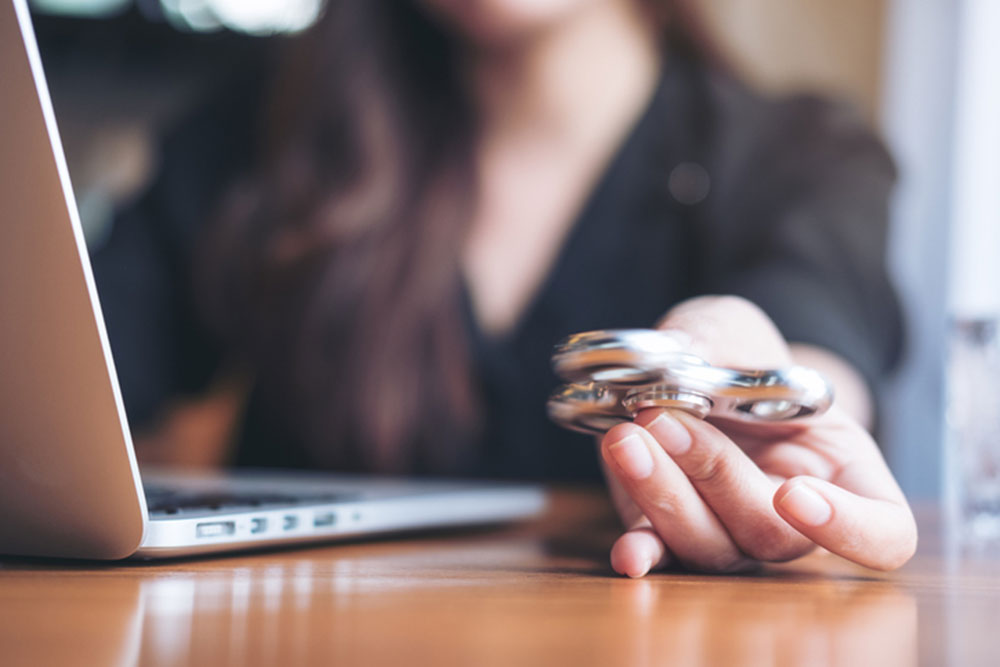
iStock
By Mary Carpenter
“Life is like riding a bicycle. To keep your balance, you must keep moving.” Albert Einstein
I am an inveterate fidgeter, doodling uncreative flowers and “removing” split ends (from my then-longish hair) through school and college years, and still “fixing” cuticles, all deemed “bad” habits that I have worked tirelessly and unsuccessfully to conquer.
In recent years, though, fidgeting has gained new respect as a means of sharpening focus and increasing attention, along with scientific respectability—and sales of so-called “fidget widgets” have soared. (“Widgets” can mean most any gadget, and recently also refers to a software application.) According to Harvard psychiatry professor John Ratey, fidgeting increases levels of the neurotransmitters and norepinephrine similarly to the effects of ADHD medication.
Medical interest in fidgeting began in the ADD community, starting in the late 1990s when gadgets, actually called “fidgets”—squishy stress balls, “magic cubes” that are variations on Rubik’s cube—became common and even on offer in special education classrooms. Attention “deficit” increases with the length, familiarity and repetitiveness of a task, according to Purdue University education studies professor Sydney Zentall. What can help the brain to focus is any activity that uses a sense other than the one required for the primary task, such as listening to music while reading.
Having ADHD may make fidgets more effective. In a 2015 study of school-age boys and girls, the 26 with ADHD gave more accurate answers on cognitive tests when they fidgeted and less accurate when they did not—compared to the 18 children without ADHD for whom fidgeting had no impact either way.
“Most major religions have some form of prayer beads — the word “bead” is derived from the Middle English word for a prayer— which are used for focusing and counting,” writes Will Dunn in The New Statesman. But in Victorian times, teachers punished fidgeting students with a stiff caning or made them wear “finger stocks” to keep their hands still. And in recent years, hundreds of schools in the U.S. have banned the spinners—which one called “helicopters of distraction.”
When sales of fidget spinners hit the big time in the late 2010s, I chose a black three-pronged gadget that twirls smoothly on ball bearings—although I haven’t mastered the suggested one-finger balance. But for occasions when I tend to fidget most, my little helicopter is either not at hand, such as for unanticipated phone conversations; inappropriate, such as when dining with others; or excessively distracting—for talking, reading and doing almost anything else.
It turns out there’s an inverted U-curve for fidgeting: The right amount can get you to a “zone” of perfect attention, but too much can impair performance. Says University of Illinois psychologist Alejandro Lleras, “When you are…stimulated in the right way, you can do things for hours.”
Since the early days of spinners, balls and cubes, new fidget-gadgets have flooded the market which includes, according to Dunn: “popping key rings, pea pod poppers (which involve squeezing little rubber peas from a rubber pod), silicone snappers, infinity cubes and an articulated plastic chain called Wacky Track—something crackles and pops in the background.”
During a six-month period in 2021, more than 12 million pop-its were sold in the U.K. —amounting to two for every primary school child—for something most prefer to call a “tool,” not a toy. Pop-its may have evolved from bubble wrap—after a 1992 study at Western New England College when 30 undergraduates, asked to pop two six-inch sheets of bubble wrap for five minutes, “reported feeling significantly more energized, less tired, and more calm,” writes Dunn. After popping little bubbles on flat plastic surfaces in an array of colors and designs, you can flip the gadget over and pop them all back again.
Sensations like the pops and squeezes produced by fidgets—called “affordances” —can have specific emotional effects, according to UC Santa Cruz computational media professor Katherine Isbister. “When people are angry, they like to squeeze something hard” — while soft furry textures can be calming.
When the spinning fidgets didn’t help me, I tried something completely different for calming the hands called Jin Shin Jyutsu, a Japanese physio-philosophy used throughout the U.S. for general relaxation and in medical settings. As described on a British Cancer center website, Jin Shin Jyutsu involves “holding the fingers [to] move through uncomfortable emotions and experiences rather than being trapped by them.”
“Gently wrapping” the fingers of one hand around each finger on the other, you hold “softly until you feel a gentle rhythmic pulse.” Each finger affects different issues: the thumb for worry, the index finger for fear, the middle finger for anger and the ring finger for sadness. The little finger has been my focus, to cover a host of issues—anxiety, insecurity, bloating, breathing—but the method proved too distracting for my fidgeting needs.
On some positive notes, I have learned that any movement, including fidgeting, at least once during each half-hour period can help counter the hypermobility, beginning with loose joints, that creates myriad problems. I am also working on general self-acceptance. But a new fidget with only two prongs that could be an improvement just arrived at my door —and to my surprise, on its surface, I found two adult-sized pop-its that so far are quite satisfying.
—Mary Carpenter regularly reports on topical issues in health and medicine.

JUST teaching 2-year-old grandson to pop bubble wrap. How satisfying. The only thing I can’t do while fidgeting is write. However. I need several hours of fidgeting to begin.